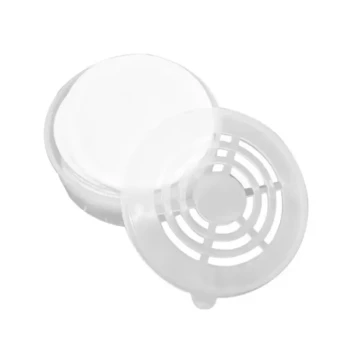At its core, the modular design of the Langstroth hive transforms beekeeping from a fixed system into a flexible, scalable operation. Its primary benefits stem from a revolutionary concept: standardized, interchangeable components. This allows beekeepers to easily expand the hive, simplify management tasks, and maximize honey production with unparalleled efficiency.
The true genius of the Langstroth hive is not just the stackable boxes, but the industry-wide standardization of those parts. This creates an accessible, efficient, and predictable system that has become the foundation of modern beekeeping.
The Foundation: Standardization and Interchangeability
The most profound benefit of the Langstroth design is not immediately visible. It's the universal agreement on dimensions that makes the entire system work.
Why Standardization Matters
Every Langstroth box, frame, bottom board, and lid is built to a specific, universal set of measurements. This means a component from one manufacturer will fit perfectly with a component from another.
This principle eliminates guesswork and vendor lock-in, creating a reliable and predictable ecosystem for equipment.
The Power of Interchangeable Parts
Because all parts are standardized, they are also interchangeable. A beekeeper can move a frame full of honey from a strong hive to a weaker one, replace a single damaged box without rebuilding the entire hive, or purchase new equipment with confidence.
This interchangeability drastically reduces long-term costs and simplifies hive maintenance.
Streamlining Hive Management and Growth
The modular design directly addresses the practical, day-to-day challenges of managing a bee colony. It provides a structured way to work with the bees' natural instincts.
Scalability for a Growing Colony
A bee colony expands and contracts with the seasons. The Langstroth hive accommodates this by allowing the beekeeper to add or remove boxes (supers) as needed.
Adding space vertically prevents the colony from feeling crowded, which is a primary trigger for swarming. This helps the beekeeper maintain a strong, productive colony.
Simplified Honey Harvesting
Bees naturally store their surplus honey above the main living quarters, or brood nest. The Langstroth design mimics this by using deeper boxes on the bottom for brood and shallower supers on top for honey.
This separation means beekeepers can remove only the honey-filled supers for harvesting, leaving the vital brood nest completely undisturbed.
Efficient Hive Inspections
Managing a colony requires periodic inspections. The modular design allows a beekeeper to examine the hive one box at a time.
This targeted approach is far less disruptive to the bees than inspecting a hive with fixed combs, leading to a calmer colony and a more focused, manageable task for the beekeeper.
Understanding the Trade-offs
While dominant, the Langstroth design is not without its challenges. Understanding these limitations is key to making an informed decision.
The Challenge of Heavy Lifting
The primary drawback of a vertical hive is weight. A deep super filled with honey can easily weigh over 60 pounds (27 kg), making lifting and manipulation a significant physical challenge for some individuals.
Variations on the Standard
To address the weight issue, beekeepers can opt for hives made entirely of medium-sized boxes or explore a Horizontal Langstroth design. A horizontal hive lays the boxes side-by-side, eliminating the need for heavy vertical lifting.
Other variations, like the Migratory lid, feature flush sides that make the hives easier to stack, secure, and transport for commercial pollination.
Making the Right Choice for Your Goal
The Langstroth hive is a tool, and its suitability depends entirely on your beekeeping objectives.
- If your primary focus is maximizing honey production and efficiency: The vertical, scalable design of the Langstroth hive is the undisputed industry standard for its high yield.
- If you are new to beekeeping and want a proven, accessible system: The widespread availability of standardized parts, mentors, and educational resources makes the Langstroth the easiest hive to learn.
- If you have concerns about heavy lifting: Consider using an 8-frame Langstroth system (which is narrower and lighter) or a Horizontal Langstroth design to avoid vertical stacking.
Ultimately, understanding the principles of modularity and standardization empowers you to select the right equipment for your specific beekeeping journey.
Summary Table:
| Benefit | Key Feature | Impact on Beekeeping |
|---|---|---|
| Scalability | Stackable boxes (supers) | Easily expand or contract hive space to match colony size, preventing swarming. |
| Simplified Management | Interchangeable frames & boxes | Conduct efficient hive inspections and maintenance with minimal disruption. |
| Efficient Harvesting | Separate brood boxes & honey supers | Harvest honey without disturbing the brood nest, maximizing yield and colony health. |
| Cost-Effectiveness | Industry-wide standardization | Mix and match parts from different suppliers, reducing long-term equipment costs. |
Ready to build a more efficient and productive apiary?
The modular Langstroth hive is the proven foundation for commercial success. At HONESTBEE, we supply high-quality, standardized beekeeping supplies and equipment in bulk to commercial apiaries and distributors. Our wholesale-focused operations ensure you get the reliable, interchangeable components you need to scale your operation with confidence.
Contact our wholesale team today to discuss your equipment needs and unlock the full potential of modular beekeeping.
Related Products
- Langstroth Bee Hives Bee Keeping Box for Beginners Beekeeping
- Long Langstroth Style Horizontal Top Bar Hive for Wholesale
- HONESTBEE Advanced Ergonomic Stainless Steel Hive Tool for Beekeeping
- Professional Dual-End Stainless Steel Hive Tool for Beekeeping
- Professional Galvanized Hive Strap with Secure Locking Buckle for Beekeeping
People Also Ask
- Why is a bee hive important for beekeeping? The Key to Healthy Bees & Productive Harvests
- What are the three main sections of a Langstroth hive? A Guide to Hive Structure & Management
- What are the key tools and equipment needed for starting a beekeeping venture? A Beginner's Essential Guide
- What are the storage demands for Langstroth hives? Plan Your Apiary for Seasonal Success
- What are some popular types of beehives used in beekeeping? Choose the Right Hive for Your Goals



















